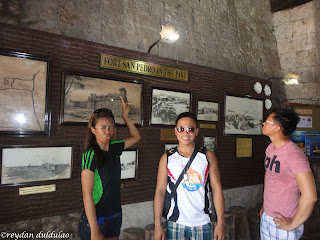Lapu-Lapu Shrine is a 20 meters bronze statue in Punta Engaño, Lapu-Lapu City, Cebu. Erected in honor of Datu Lapu-Lapu, a native leader who defeated Spanish soldiers and where the Portuguese explorer Ferdinand Magellan was killed in the Battle of Mactan on 1521.
 |
| My colleagues! |
FERDINAND MAGELLAN'S DEATH: On this spot Ferdinand Magellan died on April 27, 1521. Wounded in an encounter with the soldiers of Lapu-Lapu, Chief of Mactan Island. One of Magellan's ships, The Victoria, under the command of Juan Sebastian Elcano, sailed from Cebu on May 1, 1521 and anchored at San Lucar de Barrameda on September 6, 1522. Thus, completing the first circumnavigation of the earth.
 |
| Me, Mau and Reygie |
"Here on 27 April 1521, Lapu-Lapu and his men repulsed the Spanish invaders, killing their leader, Ferdinand Magellan. Thus Lapu-Lapu became the First Filipino to have repelled European aggression."
We enjoyed strolling the place. That will be proven through our pictures below. We did crazy things around. Took a lot of pictures where ever we go. Pose here and there! As if we were not tired after the race. We enjoyed shopping also. I got my I LOVE CEBU shirt. Visit this place when you are in Cebu, a must!

































